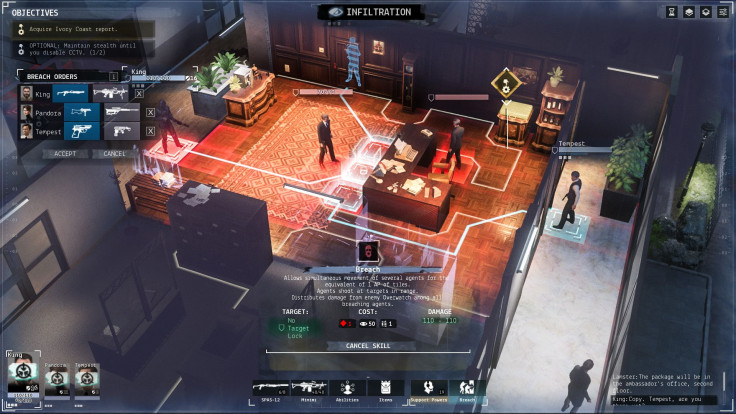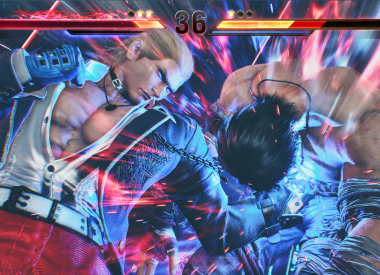CreativeForge Games wants to cut a new path through the tactical strategy genre with its next game, Phantom Doctrine. The project’s Cold War setting may be well-worn territory for tales of espionage. But it also allows for the implementation of concepts and mechanics we’ve never seen before, including new ideas on the risks and rewards of combat.
Phantom Doctrine is the latest project from the brains behind Hard West. Gone is the Old West setting of its predecessor, replaced by the simmering tensions and laughably outdated technology of the 1980s. Players control a CIA or KGB agent, each with their own campaign, trying to stop a massive conspiracy that threatens mankind. Every mission can be completed quietly or loud. And it’s up to the player to decide which strategy will be most advantageous, given the current circumstances on and off the battlefield.
Player.One spoke to Phantom Doctrine Narrative Designer Pawel Kroenke and CreativeForge Games Head of Business & Marketing Blazej Krakowiak about everything from the game’s setting to its research and investigation mechanics (more on those soon). But the minutes spent discussing Phantom Doctrine’s reinforcement systems, and the reasons one might want to alert conspiracy forces, were some of the most fascinating moments of the chat.
Admittedly, reinforcements don’t sound very interesting at first. Tactical strategy games typically use backup to increase the difficulty of certain missions or nonverbally communicate that the current goal is survival (instead of battlefield dominance). But Phantom Doctrine is all about espionage and the goal (generally speaking) is to finish missions without raising any alarms. Unfortunately, even the best plans don’t always work out in our favor.
The skill of incoming reinforcements escalate over time in Phantom Doctrine, beginning with low-level law enforcement and working up from there. Given how the odds are stacked against the player, the presence of any additional enemies will feel like a tremendous burden in the early game. But it’s also the only way to come face to face with the real enemy.
“It’s not like the conspiracy is holding a standing army that’s just waiting for you to appear,” Kroenke told Player.One. “Most often, you will enter a location that’s just a regular place. You’ll have some cops hanging around and you’ll have some civilians. Maybe, inside the target building, there will be a couple guards who aren’t really police. They’re just thugs hired to protect this place. But they’re all pretty generic enemies. The police might have a pistol or shotgun.”
“But once the reinforcements come, it’s a whole different thing,” he added. “They may start out with more cops or the SWAT team. But ultimately, the conspiracy will send their mercenaries.”
Mercenaries are highly-trained combatants who, like your own special agents, have access to the best weapons and spy tech in the world. They’ll be well-trained, with more skills and abilities than the average police officer. The duo likens conspiracy reinforcements to the arrival of an Agent in The Matrix. Conspirators don’t teleport into battle or slip into the bodies of soldiers. But you’ll always be cognizant of their presence. Eventually, you might even want them to be there.
“They are not just pawns. They’re the actual inside people,” Krakowiak explained. “If you can capture them, if you can get something out of them, maybe they’ll lead you to your next objective or maybe they’ll reveal something.”
And that’s what makes the reinforcements so interesting. Phantom Doctrine asks players to fight an uphill battle from start to finish. But every time a new enemy steps onto the scene, there’s a little silver lining. Maybe that’s a conspirator who can tell you where one of your captured agents is being held. Perhaps they can provide useful intel on a nearby hideout. Or possibly , in your quest for new information, you bit off more than you can chew and didn’t realize it until it was too late.
“We’re doing things to try and put pressure on players,” Krakowiak said “Enemies use different points of entry. They use flashbangs. They use helicopters and strafing runs from airplanes if you escalate this enough. So things get very heated, very quickly. And that’s something players need to keep in mind. Of course, it’s possible to fight your way through. There and back. That’s a promise. It’s just challenging and there’s a different mindset you have to apply to it.”
For more on Phantom Doctrine, check out our hands-on impressions from PAX West or our story on the inspiration behind the game’s Cold War setting. And we’ll have more from our interview with Pawel Kroenke and Blazej Krakowiak in the coming days.
Phantom Doctrine is in development for PC and scheduled to debut in 2018.
Be sure to check back with Player.One and follow Scott on Twitter for more Phantom Doctrine news in 2017 and however long CreativeForge supports Phantom Doctrine after launch.



















